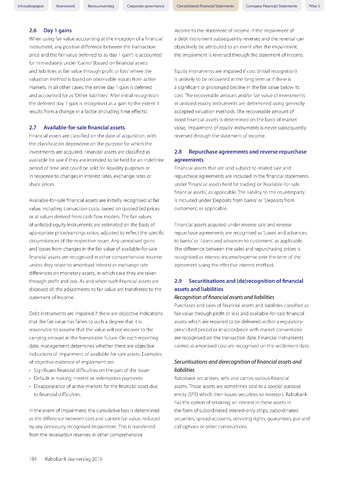Inhoudsopgave Voorwoord Bestuursverslag Corporate governance
Consolidated Financial Statements Company Financial Statements Pillar 3
2.6 Day 1 gains
When using fair value accounting at the inception of a financial
instrument, any positive difference between the transaction
price and the fair value (referred to as day 1 gain') is accounted
for immediately under'Gains/ (losses) on financial assets
and liabilities at fair value through profit or loss'where the
valuation method is based on observable inputs from active
markets. In all other cases, the entire day 1 gain is deferred
and accounted for as 'Other liabilities'. After initial recognition
the deferred day 1 gain is recognised as a gain to the extent it
results from a change in a factor (including time effects).
2.7 Available-for-sale financial assets
Financial assets are classified on the date of acquisition, with
the classification dependent on the purpose for which the
investments are acquired. Financial assets are classified as
available for sale if they are intended to be held for an indefinite
period of time and could be sold for liquidity purposes or
in response to changes in interest rates, exchange rates or
share prices.
Available-for-sale financial assets are initially recognised at fair
value, including transaction costs, based on quoted bid prices
or at values derived from cash flow models.The fair values
of unlisted equity instruments are estimated on the basis of
appropriate price/earnings ratios, adjusted to reflect the specific
circumstances of the respective issuer. Any unrealised gains
and losses from changes in the fair value of available-for-sale
financial assets are recognised in other comprehensive income
unless they relate to amortised interest or exchange rate
differences on monetary assets, in which case they are taken
through profit and loss. As and when such financial assets are
disposed of, the adjustments to fair value are transferred to the
statement of Income.
Debt instruments are impaired if there are objective indications
that the fair value has fallen to such a degree that it is
reasonable to assume that the value will not recover to the
carrying amount in the foreseeable future. On each reporting
date, management determines whether there are objective
indications of impairment of available-for-sale assets. Examples
of objective evidence of impairment are:
Significant financial difficulties on the part of the issuer
Default in making interest or redemption payments
Disappearance of active markets for the financial asset due
to financial difficulties.
In the event of impairment, the cumulative loss is determined
as the difference between cost and current fair value, reduced
by any previously recognised impairment.This is transferred
from the revaluation reserves in other comprehensive
income to the statement of income. If the impairment of
a debt instrument subsequently reverses and the reversal can
objectively be attributed to an event after the impairment,
the impairment is reversed through the statement of income.
Equity instruments are impaired if cost (initial recognition)
is unlikely to be recovered in the long term or if there is
a significant or prolonged decline in the fair value below its
cost. The recoverable amount and/or fair value of investments
in unlisted equity instruments are determined using generally
accepted valuation methods.The recoverable amount of
listed financial assets is determined on the basis of market
value. Impairment of equity instruments is never subsequently
reversed through the statement of income.
2.8 Repurchase agreements and reverse repurchase
agreements
Financial assets that are sold subject to related sale and
repurchase agreements are included in the financial statements
under'Financial assets held for trading'or'Available-for-sale
financial assets', as applicable. The liability to the counterparty
is included under'Deposits from banks'or'Deposits from
customers', as applicable.
Financial assets acquired under reverse sale and reverse
repurchase agreements are recognised as 'Loans and advances
to banks' or 'Loans and advances to customers', as applicable.
The difference between the sales and repurchasing prices is
recognised as interest income/expense over the term of the
agreement using the effective interest method.
2.9 Securitisations and (de)recognition of financial
assets and liabilities
Recognition of financial assets and liabilities
Purchases and sales of financial assets and liabilities classified as
fair value through profit or loss and available-for-sale financial
assets which are required to be delivered within a regulatory-
prescribed period or in accordance with market conventions
are recognised on the transaction date. Financial instruments
carried at amortised cost are recognised on the settlement date.
Securitisations and derecognition of financial assets and
liabilities
Rabobank securitises, sells and carries various financial
assets. Those assets are sometimes sold to a special purpose
entity (SPE) which then issues securities to investors. Rabobank
has the option of retaining an interest in these assets in
the form of subordinated interest-only strips, subordinated
securities, spread accounts, servicing rights, guarantees, put and
call options or other constructions.
184 Rabobank Jaarverslag 2016

